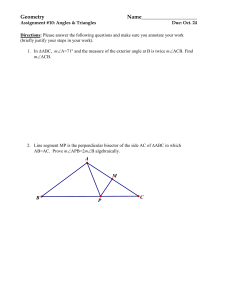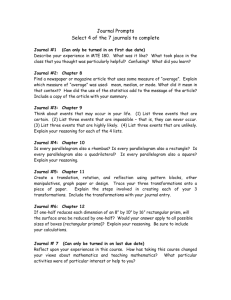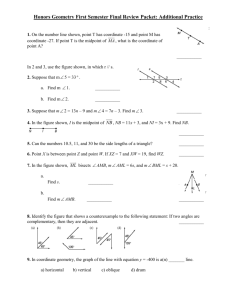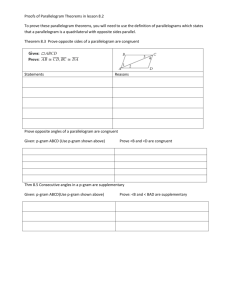Geometry-Final Study Guide-Semester 1-2014
advertisement
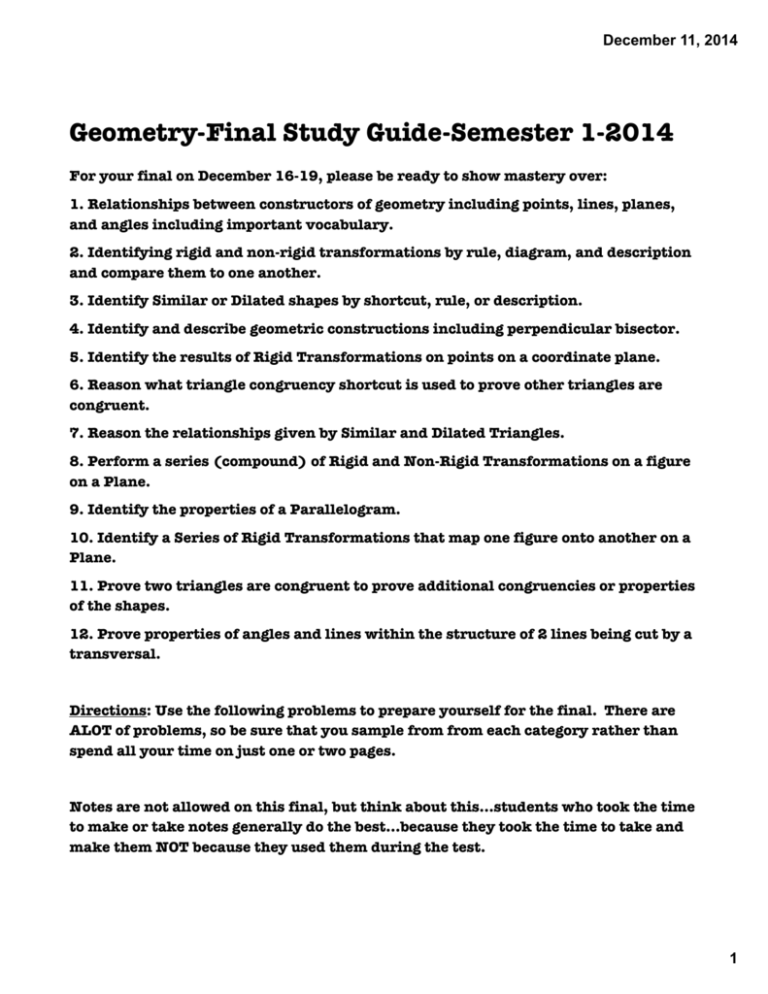
December 11, 2014 Geometry-Final Study Guide-Semester 1-2014 For your final on December 16-19, please be ready to show mastery over: 1. Relationships between constructors of geometry including points, lines, planes, and angles including important vocabulary. 2. Identifying rigid and non-rigid transformations by rule, diagram, and description and compare them to one another. 3. Identify Similar or Dilated shapes by shortcut, rule, or description. 4. Identify and describe geometric constructions including perpendicular bisector. 5. Identify the results of Rigid Transformations on points on a coordinate plane. 6. Reason what triangle congruency shortcut is used to prove other triangles are congruent. 7. Reason the relationships given by Similar and Dilated Triangles. 8. Perform a series (compound) of Rigid and Non-Rigid Transformations on a figure on a Plane. 9. Identify the properties of a Parallelogram. 10. Identify a Series of Rigid Transformations that map one figure onto another on a Plane. 11. Prove two triangles are congruent to prove additional congruencies or properties of the shapes. 12. Prove properties of angles and lines within the structure of 2 lines being cut by a transversal. Directions: Use the following problems to prepare yourself for the final. There are ALOT of problems, so be sure that you sample from from each category rather than spend all your time on just one or two pages. Notes are not allowed on this final, but think about this...students who took the time to make or take notes generally do the best...because they took the time to take and make them NOT because they used them during the test. 1 December 11, 2014 Important Vocab for the Final. 1. Vertical Angles/Vertical Angle Theorem 2. Base Angles/Base Angle Theorem 3. Corresponding 4. Corresponding Angle Postulate, Alternate Interior Angles Theorem 5. Linear Pair Postulate 6. CPCTC 7. SSS, SAS, AAS, ASA, SSA 8. Definition of Supplementary Angles 9. Rigid/Non-Rigid Transformations 10 Parallelogram (properties and stuff) 11. Bisector 12. Perpendicular Bisector 13. Midpoint 14. Preserve 15. Orientation 2 December 11, 2014 1. Relationships between constructors of geometry including points, lines, planes, and angles in B. If AB is a bisector of <DAC, and AR is a bisector of <DAB, what is the measure of m<DAC is 120, what is m<DAR? A. Sketch <ABC so that m<ABC = 90 Add BD so that BD bisects <ABC What is m<ABD? B C. A B C D E B is a bisector of AE C is a midpoint of BE D is bisector of CE If AC = 18, what is CD? What is BD? D. A C D E F m<AFE is 150. FB is a bisector of <AFE FC is a bisector of <BFE FD is a bisector of <CFE What is m<BFD? 3 December 11, 2014 2. Identifying rigid and non-rigid transformations by rule, diagram, and description and compare them to one another. Ok, so here's the deal. Problems on the final are taken DIRECTLY from the Khan Academy recommendation "Qualitatively Defining Rigid Transformations." If you want to prepare for this section, you have to be able to do these problems. They have been re-recommended for you. 4 December 11, 2014 3. Identify Similar or Dilated shapes by shortcut, rule, or description. 4. Identify B and describe geometric constructions including perpendicular bisector. 5. Identify the results of Rigid Transformations on points on a coordinate plane. 8. Perform a series (compound) of Rigid and Non-Rigid Transformations on a figure on a Plane. b. Sketch out a series of transformations that will map BROW to LAMP. Diagram all vectors, lines of reflection, centers and angles of rotation, and centers and factors of dilation where applicable. a. Take the figure below through the following transformations: R Step 1: (x, y) --> (-x, y) to take ABC --> A'B'C' Step 2: Map A'B'C' to A''B''C'' by <-4, 5> Step 3: Dilate A''B''C'' to A'''B'''C''' by center (0,0) and scale factor of 2 B O M W A P L B A C d. Select all of the following descriptions that will map a given figure onto itself. y c. Are the two triangles below Similar? Explain your thinking regardless of your answer. 1 A 2 x iv. Reflect over x = 3.5 2 N ii. Reflect over y- axis iii. Reflect over Line G I Line G i. Reflect over x-axis v. Reflect over x = 4.5 3 vi. Reflect over y = -1.5 vii. Reflect over y = -4.5 1.5 P viii. Reflect over the line through (-1,3) and (8, -6) 4 C 5 December 11, 2014 6 December 11, 2014 Prove: AC = DB Given: C is the midpoint of BE <ABC = <DEC Prove: <CAB = <CDE Given <1≅<8, Prove*<4*≅<5 . 7 December 11, 2014 Given:* BOAT*is*a*parallelogram Prove:* A*diagonal*will*cut*it*into*2*congruent*triangles Given: THIN is a parallelogram Prove: THK = NIK H I K T N Identify all the definitions and properties of a parallelogram. - 8 December 11, 2014 Prove bgf≅ dgf Given: b and d are midpoints. c g b a f d e 9 December 11, 2014 10


